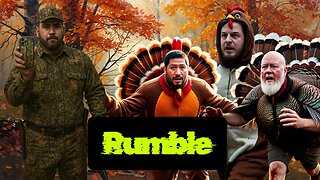Premium Only Content

Episode 2800: Advent Course - Word Made Flesh - Session 4 - Three Comings of Christ
Theme: Christ as the Alpha and the Omega
Introduction and Opening Prayers (10 minutes)
Let us begin this time together by entrusting our hearts and minds to the Lord in prayer, asking Him to guide us into a deeper understanding of His love and His eternal plan.
Advent Wreath
The Fourth Week The father of the household and the middle children light all four candles in proper sequence during the fourth week after repeating the following prayer. Father: “O Lord, stir up Thy power, we pray Thee, and come; and with great might help us, that with the help of Thy Grace, thy merciful forgiveness may hasten what our sins impede. Through Christ our Lord. Amen.” 1 Our Father, 1 Hail Mary – Holy Mary and 1 Glory Be
O Antiphons of Advent (Started December 17th)
December 22: O Rex Gentium (O King of the Nations) O King of the Nations, and their desired One, the Cornerstone that makes both one: come and save mankind, whom You formed from the dust of the earth.
Welcome and Introduction
Opening Greeting
• Welcome everyone to today’s session on the theme of “Christ’s Three Comings: Past, Present, and Future.”
• Briefly acknowledge the significance of gathering together to deepen our understanding of this central mystery of our faith.
• Express gratitude for their presence and attentiveness, as this topic invites us to reflect not only on theological truths but also on their transformative power in our daily lives.
Introducing the Theme
• The three comings of Christ His Incarnation, His presence among us today in the Eucharist and Sacraments, and His return in glory are at the heart of the Christian faith. These are not isolated events but interconnected realities that reveal the fullness of God’s plan for our salvation.
• Today, we will explore these three comings to better understand how they shape our relationship with Christ and call us to live in hope, humility, and holiness.
The Alpha and the Omega: A Unifying Symbol
• In the Book of Revelation, Jesus declares:
“I am the Alpha and the Omega, the First and the Last, the Beginning and the End.” (Revelation 22:13)
• These words remind us that Christ is eternally present. He transcends time as the Creator of all things, the Savior who entered human history, and the King who will come again in glory.
• Alpha and Omega, the first and last letters of the Greek alphabet, symbolize Christ’s sovereignty over all time. Everything begins and ends in Him, making Him the anchor of our faith and the source of our hope.
The Significance for Our Lives
• By contemplating Christ as the Alpha and Omega, we are invited to:
o Look backward with gratitude at His birth in Bethlehem.
o Embrace His presence here and now, especially in the Eucharist and Sacraments.
o Look forward with hope and anticipation to His glorious return.
Framing the Session
• Over the course of this session, we will:
o Reflect on Scripture passages that illuminate Christ’s three comings.
o Delve into the historical, sacramental, and eschatological dimensions of His presence.
o Discuss how these truths shape our spiritual lives and practical actions.
________________________________________
Part 1: Scripture Reflection (20 minutes)
1. Revelation 22:12-13 (5 minutes)
a. Reading the Passage Aloud (1-2 minutes)
“Behold, I am coming soon, bringing my recompense with me, to repay each one for what he has done. I am the Alpha and the Omega, the first and the last, the beginning and the end.” (Revelation 22:12-13)
b. Reflection on Christ as the Beginning and End of All Things (3-4 minutes)
Christ’s Eternal Nature (1-2 minutes)
Begin by reflecting on the eternal nature of Christ, drawing from Revelation 22:12-13:
“I am the Alpha and the Omega, the first and the last, the beginning and the end.”
• As Alpha:
o Christ is the Creator, the source of all life and existence.
o Through Him, all things were made (John 1:3). Without Him, nothing that exists would have come to be. He is the origin of the cosmos and the spark of our individual lives.
• As Omega:
o Christ is also the fulfillment, the ultimate purpose of all creation.
o All things are moving toward Him, and in Him, creation finds its completion and glory.
These truths affirm Christ’s sovereignty over history—He stands outside of time yet intimately enters it to guide us toward eternity.
________________________________________
Personal Reflection (1-2 minutes)
• Christ is both the origin and the destiny of our lives:
o We were made through Him, and every breath we take is sustained by His love.
o Our ultimate purpose, however, is not merely to live in this world but to be united with Him forever in heaven.
• Reflecting on this truth challenges us to ask:
o How do we view our daily lives in light of eternity?
o Are we actively striving to align our actions, choices, and goals with the destiny Christ has prepared for us?
This perspective invites us to see our lives as part of a greater narrative that begins and ends in Christ.
________________________________________
Challenge for Daily Living (1 minute)
• Recognize Christ’s Presence:
o In every moment, Christ is present whether in the joy of creation, the trials of life, or the hope of redemption.
o He is both the reason we began and the destination we are moving toward.
• Practical Application:
o Begin each day with the acknowledgment of Christ as your Alpha, thanking Him for life and blessings.
o End each day with gratitude and trust, offering your struggles and successes to Him as your Omega.
Living this way allows us to stay mindful of Christ’s eternal role in our lives, inspiring us to approach each moment with purpose and hope.
________________________________________
Matthew 25:31-46 (10 minutes)
a. Reading the Passage (3-4 minutes)
• Read the Gospel passage aloud, focusing on the vivid imagery of the Final Judgment.
“When the Son of Man comes in his glory, and all the angels with him, then he will sit on his glorious throne...”
b. Reflection and Discussion (6-7 minutes)
1. The Final Judgment (2 minutes)
Begin by reflecting on Matthew 25:31-46, focusing on Christ’s role as King and Judge:
“When the Son of Man comes in his glory, and all the angels with him, then he will sit on his glorious throne. Before him will be gathered all the nations.”
• At His Second Coming, Christ will not appear as the humble servant but as the King of Glory who will judge all nations.
• Eternal destiny hinges on how we live out the Corporal Works of Mercy, as shown in this passage.
o Feeding the hungry.
o Giving drink to the thirsty.
o Welcoming strangers.
o Clothing the naked.
o Visiting the sick and imprisoned.
• Judgment is not based merely on belief but on how we have responded to Christ’s command to love others through action.
________________________________________
The Call to Mercy (2 minutes)
This passage challenges us to reflect deeply on our attitudes and actions toward those in need:
• Seeing Christ in Others:
o Jesus identifies Himself with “the least of these.” When we serve the hungry, naked, or imprisoned, we are serving Christ Himself.
o Acts of mercy demand not just generosity but a recognition of the sacred dignity of every person.
• A Non-Negotiable Mandate:
o Acts of mercy are not optional extras for Christians—they are the criteria for judgment.
o True discipleship is measured by our willingness to love and serve those in need, even when it’s inconvenient or difficult.
Consider: Are there opportunities to serve Christ in your daily life that you might be overlooking?
________________________________________
Living in Anticipation (2 minutes)
This reflection invites us to adopt an eternal perspective in our daily lives:
• Practicing Mercy Today:
o Each act of mercy prepares our hearts for Christ’s return.
o By choosing compassion, we cultivate a readiness for His judgment.
• A Question to Reflect On:
o Ask yourself, “Am I living as if Christ might come tomorrow?”
o Consider: If Christ returned today, would your life reflect readiness through love and mercy?
________________________________________
Interactive Discussion (1-2 minutes)
Pose these questions to the group or yourself:
• How can you make acts of mercy a daily priority in your life?
• What challenges or obstacles might prevent you from living out mercy?
• Share a time when you saw Christ in another person through an act of kindness or service.
This reflection calls us not only to examine our actions but to renew our commitment to living in a way that glorifies Christ as King and Judge.
Would you like to include specific examples of modern-day Corporal Works of Mercy or a short closing prayer for this section?
________________________________________
3. Interactive Discussion (5 minutes)
a. Prompt Participants:
• Invite participants to reflect on and share their responses to this question:
“What does it mean for Christ to be both the Alpha and the Omega in your life?”
b. Potential Discussion Points:
• Personal Applications:
o Some may see Christ as the guide for their past decisions and their hope for the future.
o Others might focus on His role in sustaining them through daily challenges.
• Living in the Present:
o How can we keep Christ at the center of our lives here and now, not just in theory but in practical ways?
• Encouraging Hope:
o Discuss how knowing Christ is the beginning and the end gives us peace amid uncertainty and trials.
________________________________________
Closing Thought for the Reflection
• Conclude the Scripture Reflection by reminding participants:
o Christ’s three comings past, present, and future call us to live intentionally, with our hearts and actions aligned to His will.
o As the Alpha and Omega, He invites us to trust in His providence and strive for holiness in anticipation of His glorious return.
________________________________________
Part 2: The Three Comings of Christ (1 hour)
Section 1: The Past – Christ’s Birth in Bethlehem (15 minutes)
1. Historical Context (5 minutes)
• Old Testament Prophecies Fulfilled:
o Isaiah 7:14: "Behold, a virgin shall conceive and bear a son, and shall call his name Immanuel."
o Micah 5:2: "But you, Bethlehem... from you shall come forth for me one who is to be ruler in Israel."
o These passages remind us of God's faithfulness and His perfect plan for salvation.
• The Incarnation:
o Jesus’ birth fulfilled centuries of prophecy, emphasizing God’s intervention in human history through humility.
2. Key Points to Emphasize (5 minutes)
• God’s Faithfulness:
o The Nativity shows God keeps His promises, a sign of His enduring love for humanity.
• Humility of Christ’s Birth:
o Christ was born in a stable, symbolizing that greatness is found in humility and service.
o Reflect on how Christ’s entry into the world challenges our perception of power and success.
3. Engagement (5 minutes)
• Show images of Nativity scenes from different cultures, emphasizing the universal significance of Christ’s birth.
• Invite participants to reflect:
o What does the Nativity mean to you personally?
o How does the humility of Christ's birth challenge your own priorities?
________________________________________
Section 2: The Present – Christ in the Eucharist and Sacraments (20 minutes)
1. The Real Presence of Christ (8 minutes)
• Transubstantiation Explained:
o Refer to John 6:51: “I am the living bread that came down from heaven; if anyone eats of this bread, he will live forever.”
o Explain that in the Eucharist, the bread and wine truly become Christ’s Body and Blood.
• Saintly Perspectives:
o St. Thomas Aquinas: "The Eucharist is the consummation of the spiritual life."
o Pope John Paul II: "The Church draws her life from the Eucharist."
2. Sacraments as Channels of Grace (7 minutes)
• Highlight the role of each sacrament in sustaining spiritual life:
o Baptism: Cleanses us of original sin and initiates us into God’s family.
o Confirmation: Strengthens us with the gifts of the Holy Spirit.
o Reconciliation: Restores our relationship with God when we fall.
o Eucharist: Nourishes us with the Body of Christ.
o Marriage, Holy Orders, and Anointing of the Sick: Channels for grace in specific vocations or circumstances.
3. Activity (5 minutes)
• Meditation on Christ’s Presence:
o Invite participants to close their eyes and reflect on the mystery of the Eucharist.
o Ask: “When you receive Christ in the Eucharist, how does it deepen your relationship with Him?”
o Conclude with a short prayer, thanking Christ for His Real Presence in the sacraments.
________________________________________
Section 3: The Future – Christ’s Return in Glory (25 minutes)
1. The Second Coming (10 minutes)
• Scriptural Reflection:
o Read Matthew 25:31-46 aloud.
o Reflect on the Parousia (Second Coming) as the culmination of salvation history, where Christ will judge the living and the dead.
• Significance for Christians:
o The Parousia reminds us of our responsibility to live in faith and charity, knowing we will be accountable for our actions.
2. Hope and Vigilance (10 minutes)
• Eternal Perspective:
o Share stories of saints who lived with joyful anticipation of Christ’s return:
St. Dominic Savio: "Death rather than sin!"
St. Teresa of Ávila: “The soul that walks in love neither tires others nor grows tired.”
• Practical Applications:
o Living with hope means aligning daily actions with eternal values.
o Emphasize vigilance in prayer, sacraments, and acts of love.
3. Reflection Exercise (5 minutes)
• Preparation for Christ’s Return:
o Provide paper and pens for participants to write down one practical way they can prepare for Christ’s return. Examples:
Committing to daily prayer.
Volunteering to serve the needy.
Recommitting to frequent reception of the sacraments.
• Conclude with a group prayer: “Come, Lord Jesus. Help us to live each day as if You might return tomorrow.”
________________________________________
Closing (2-3 minutes)
• Summarize the key points from each section:
1. Christ came humbly in Bethlehem to fulfill God’s promises.
2. Christ is present today in the Eucharist and sacraments as our source of grace.
3. Christ will return in glory, calling us to live in faith, hope, and love.
• End with a prayer of thanksgiving and anticipation:
“Lord, thank You for coming to us in the past, for being with us in the present, and for the hope of Your future return. May we always live in Your love. Amen.”
________________________________________
Part 3: How the Three Comings Shape Our Lives (20 Minutes)
1. Theological Reflection (7 Minutes)
A. Recap of the Three Comings (3 Minutes)
1. The Past: Christ’s Birth in Bethlehem
o Highlight the fulfillment of Old Testament prophecies through the Incarnation.
o Reflect on how Christ’s first coming reveals God’s humility and love.
2. The Present: Christ in the Eucharist and Sacraments
o Emphasize Christ’s ongoing presence in the world through the Real Presence in the Eucharist and the life-giving sacraments.
o Invite participants to see how this sustains and prepares us for His return.
3. The Future: Christ’s Return in Glory
o Share the hope and promise of Christ’s Second Coming, when He will bring justice, establish His eternal kingdom, and fulfill all creation.
B. Advent and Christmas Reflections (4 Minutes)
1. Advent:
o A time of waiting and preparation that mirrors the anticipation of Christ’s Second Coming.
o Encourage participants to reflect on their own spiritual readiness during this season.
2. Christmas:
o Celebrates the gift of God becoming man and the joy of His presence among us.
o Connect the celebration of Christ’s birth to the ongoing anticipation of His return.
3. Challenge:
o Ask participants:
How can the themes of Advent and Christmas help deepen our understanding of the three comings?
What concrete steps can we take to make Advent more spiritually fruitful?
________________________________________
2. Group Discussion (7 Minutes)
A. Instructions (2 Minutes)
1. Divide participants into small groups of 3–5 people.
2. Provide discussion prompts:
o “How can we prepare for Christ’s return in our personal lives?”
o “What role does the Eucharist play in our anticipation of Christ’s Second Coming?”
B. Group Conversations (5 Minutes)
1. Encourage participants to share personal insights, experiences, and reflections.
2. Provide examples to spark discussion:
o Daily prayer or Eucharistic adoration as ways to stay vigilant.
o Acts of mercy as a reflection of Christ’s love and preparation for His judgment.
3. Remind participants to consider practical actions they can implement in their lives.
________________________________________
3. Sharing Insights (6 Minutes)
A. Group Presentations (4 Minutes)
1. Have each group select one member to share a key takeaway or insight.
2. Summarize common themes:
o The importance of vigilance and prayer in preparing for Christ.
o How the Eucharist strengthens us in our daily journey toward holiness.
o Ways to live Advent and Christmas with greater intention.
B. Facilitator Reflection (2 Minutes)
1. Acknowledge the richness of the insights shared and the call to live as disciples in anticipation of Christ’s return.
2. Encourage participants to take their reflections into their daily lives by deepening their connection to Christ in the Eucharist and practicing acts of mercy.
________________________________________
Practical Application and Closing (30 minutes)
1. Call to Action (10 Minutes)
A. The Importance of Spiritual Preparation (5 Minutes)
1. Advent as a Time for Renewal:
o Reflect on Advent as a season of hope, repentance, and preparation for Christ’s coming.
o Tie this reflection to the session’s themes of vigilance and readiness for His return.
2. The Sacrament of Confession:
o Highlight the significance of confession in preparing our hearts for Christ.
o Discuss how confession restores our relationship with God and helps us live in grace.
o Reference John 20:22-23: “Whose sins you forgive are forgiven them, and whose sins you retain are retained.”
B. Practical Steps for Confession (5 Minutes)
1. Examination of Conscience:
o Provide a brief overview of how to reflect on one’s life in light of the Ten Commandments and the Beatitudes.
o Suggest resources such as traditional Catholic guides for examination of conscience.
2. Tips for a Fruitful Confession:
o Approach with humility and a contrite heart.
o Be honest, concise, and open to the priest’s counsel.
3. Commitment to the Sacrament:
o Challenge participants to schedule a confession before Christmas.
o Encourage bringing family members or friends as a way to inspire others to receive grace.
________________________________________
2. Open Q&A (20 Minutes)
A. Guidelines for the Q&A (2 Minutes)
1. Invite participants to ask questions related to:
o The theological insights shared during the session.
o How to incorporate the themes of Christ’s three comings into daily life.
o Practical advice for Advent practices, confession, and Eucharistic devotion.
2. Remind participants to keep questions concise to allow for multiple voices.
B. Facilitated Discussion (15 Minutes)
1. Common Questions to Address:
o “How can I deepen my understanding of Christ’s Real Presence in the Eucharist?”
o “What are practical ways to stay vigilant and spiritually prepared for Christ’s return?”
o “How do I encourage others to return to confession or the Church during Advent?”
2. Encourage Sharing:
o Allow participants to share their own experiences or advice related to the themes.
C. Wrap-Up of Q&A (3 Minutes)
1. Summarize key insights or recurring themes from the questions and discussions.
2. Reiterate the importance of integrating spiritual practices into daily life to prepare for Christ’s coming.
________________________________________
3. Closing Reflection and Prayer (5 Minutes)
A. Final Reflection (2 Minutes)
1. Encourage participants to take a moment to reflect on the session and their personal takeaways.
2. Pose a reflective question:
o “What one action can you commit to this Advent to deepen your relationship with Christ?”
B. Closing Prayer (3 Minutes)
1. Offer a prayer of thanksgiving and supplication:
o Example Prayer:
“Heavenly Father, we thank You for the gift of Your Son, who came to us as a humble child, remains with us in the Eucharist, and will return in glory. Help us to prepare our hearts and lives to meet Him with joy and faithfulness. Bless us in this Advent season as we seek Your grace and mercy. Amen.”
2. Conclude with a moment of silence for personal prayer and commitment.
1. Closing Prayer
o Pray the Act of Contrition.
o Conclude with a communal hymn, such as "O Lo How A Rose Er Blooming"
-
 8:26
8:26
Hollywood Exposed
16 hours agoKid Rock LEAVES Bill Maher Scrambling After Trump Debate Gets Messy
13.2K11 -
 2:05:21
2:05:21
BEK TV
3 days agoTrent Loos in the Morning - 11/17/2025
11K2 -
 9:25
9:25
MattMorseTV
16 hours ago $47.55 earnedTrump’s GAMBLE just PAID OFF… BIG TIME.
59.2K100 -
 18:03
18:03
Nikko Ortiz
21 hours agoNikko Ortiz Night Routine...
111K19 -
 LIVE
LIVE
FyrBorne
12 hours ago🔴Battlefield REDSEC Live M&K Gameplay: Pyro+ Games
146 watching -
 LIVE
LIVE
Lofi Girl
3 years agolofi hip hop radio 📚 - beats to relax/study to
363 watching -
 2:12:56
2:12:56
BBQPenguin_
4 hours agoEscape From Tarkov 1.0 Wipe! New Story & Full Release!
6.69K -
 1:48:07
1:48:07
Midnight In The Mountains™
2 hours agoMorning Coffee w/ Midnight & The Early Birds of Rumble
5.43K2 -
 24:21
24:21
a12cat34dog
1 day agoGUITAR HERO AT DREAMHACK | HALLOWEEN 2025
22.8K11 -
 4:14:04
4:14:04
B2ZGaming
10 hours agoB2Z.... Assemble! | B2Z Gaming
5.35K